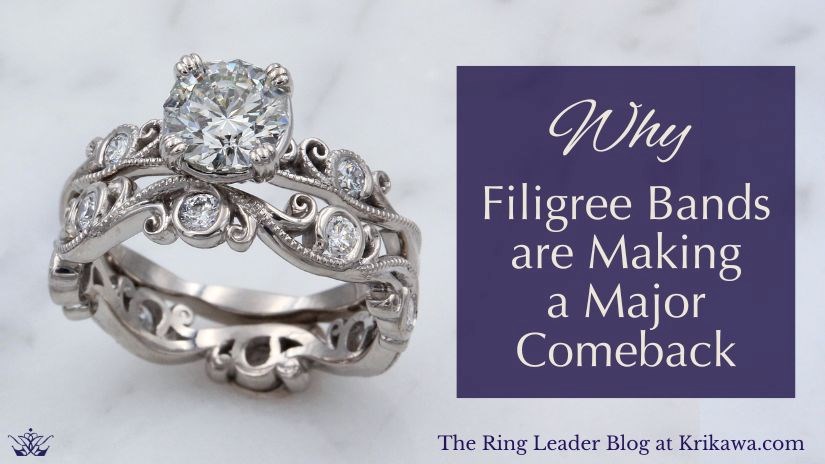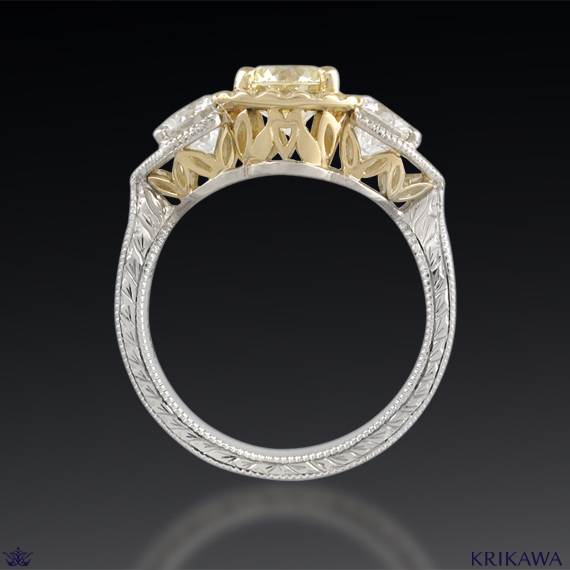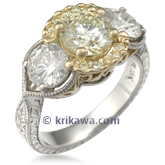
Oct 31, 2025
Why Filigree Rings Are Making a Major Comeback

LISA
Summary: Filigree is back for its visible craftsmanship, light feel, and custom motifs. This guide explains the technique, what to look for, and simple care tips—plus ideas for designing a filigree ring for daily wear.
Krikawa Key takeaways:
- Filigree uses fine metal wires to create strong, lacy patterns.
- It offers big visual impact with a light, comfortable profile.
- Affordability when the spot price of gold and platinum is at all time highs
- Personalization options include shoulders, under-gallery, and band details.
- Choose protected designs for daily wear; clean gently and check joins.
- Vintage look, modern build: easy to pair with natural or lab-grown stones
Your social media feeds are probably filled with it: you’re suddenly awash in gorgeously airy scrolls and lace-like details in precious metals trending in jewelry. For vintage lovers, it may be nothing new to them—but for most, you may ask: what’s with that?
The filigree ring is having a full-on second renaissance, and in our quick guide, we’ll share what filigree is, why it’s trending again, and how you can choose or design rings with filigree that complement your lifestyle, who you truly are as a person, and what story you want to tell through your handcrafted rings.
What is Filigree, really?
Filigree is a traditional metalworking technique in which a jeweler curls, twists, and solder ultra-fine precious metal threads into delicate openwork patterns. They create exquisite vines, arabesques, or tiny spirals rendered in gold, platinum, and other precious metals. The Encyclopedia Britannica describes filigree as “delicate, lace-like ornamental openwork…of intertwined wire threads,” a craft used in jewelry since antiquity.
Across centuries and cultures, makers have pushed filigree in different directions—from bold, architectural wirework to delicate, whisper-thin patterns that allow light to pass through. GIA research notes that families of techniques (plating, jointing, piling) are still practiced today, showing the filigree’s blend of art and engineering.
A Timeless Technique with Deep Roots
Filigree may seem like a fad, but it is a piece of history in miniature form. Oxford Reference dates its use back to the third millennium BCE, with Sumerian craftsmen. Museums around the world hold examples, such as an 11th-century gold ring in the Fatimid technique and an 18th-19th-century necklace with filigree and beads, both at The Metropolitan Museum of Art.
This through-line, from ancient makers to modern studios, is part of why many of today’s couples are rediscovering and falling in love with filigree.
Why Filigree Rings are Back on Top
1. Craftsmanship you can see and feel.
Today, many jewelry styles have leaned toward more modern and sleek lines. These are beautiful, but they do not always represent everyone’s tastes. A filigree ring showcases delicate, meticulous, handmade artwork in precious metals daily.
Every curve is a decision, every solder a point, and every breath held. That tactical quality satisfies a growing appetite for objects and pieces with soul, artistry, and story woven together.
2. Lightness Without Losing Presence
Because filigree utilizes openwork (negative space), pieces can appear substantial on the finger without excessive metal weight. This lace-like construction also requires fewer raw materials, making it an elegant way to achieve visual impact with light, airy comfort.
3. Vintage Aesthetics, Modern Ethics
Many clients are inspired by heirloom appeal, like Edwardian-inspired vintage filigree rings—while wanting contemporary materials or stones (including eco-conscious lab-grown). Filigree bridges that gap: a historical look with a customized build.
4. Infinite Personalization
Filigree scales wonderfully. You can weave initials into a gallery, echo a favorite bloom, or run a slender filigree ring band around the shank (the circular band of a ring that fits around the finger and provides the structural base for the rest of the ring’s design). If you love openwork or supported filigree (wire over a solid back), the motifs can be tuned to your daily habits and what’s comfortable for you to wear.
Which Should You Choose: Vintage vs. New?
A pre-loved, heirloom vintage filigree ring carries a past, history, and romantic patina that should feel right to you. Ensure you check the integrity of the wirework and whether or not past repairs have been done.
If you love the look but prefer tailored proportions around what speaks to you (stone size, profile height, metal color, patterns, motifs), commissioning a new filigree ring band gives you all that freedom and much more.
Either way, filigree’s versatility allows you to honor tradition while making it unmistakably one-of-a-kind and truly yours.
What to Beware of With Trendy Filigree Rings
Trendy filigree engagement rings, with their intricate lace-like designs, can be captivating, but it’s important to look beyond their beauty before choosing one.
Fine filigree work often involves delicate wire patterns that are TOO delicate, and can be more susceptible to bending, snagging, or damage from everyday wear. The uber-narrow engagement rings seen all over Instagram and Pinterest are often just too narrow for a lifetime of wear.
Always check that the ring’s craftsmanship matches its style, ensuring strong structural support around the center stone and quality metalwork that can withstand time, not just current trends.
Krikawa Quick Tips: How to Pick (Or Design) a Filigree Ring
- Decide where you want the details. Popular placements include shoulder scrolls, a filigreed under-gallery (or hidden halo), or delicate filigree on the ring sides to maintain a clean top view.
- Match metal to pattern. Platinum excels at ultra-fine, crisp lines, while higher-karat gold gives scrollwork and flowers a warm glow.
- Think about everyday wear. Are you hard on your hands or work with them constantly? Choose protected filigree (set within frames) or slightly heavier wire gauges; reserve the ultra-etherical and light openwork for dressier wear rings.
From Spark to Sketch: Let’s Design Your Filigree, Together
Filigree’s comeback makes perfect sense: it offers visible handmade craftsmanship, graceful lightness, and heirloom-worthy designs you can personalize. From airy Art Nouveau flourishes to crisp geometric wirework (or even some popular modern media motifs), a filigree ring is an opportunity to tell the story of your life, love, and values in gorgeous, wearable art.
Have we sparked your interest? Are you curious how your favorite motifs can be translated into a ring with filigree? Our designers would be delighted to discuss sketches, proportions, and stone options with you!
Whether remotely or with us in the studio, why not contact us about your ideas for a custom filigree ring?
We’d love to work with you until we find the design of your dreams and it feels just right.
Would you like to learn more about the historical facts surrounding filigree rings?
- GIA (Gemological Institute of America) — Filigree Inlay Art: The Intangible Cultural Heritage of China
- The Metropolitan Museum of Art — Gold Ring in Filigree Technique (11th century)
- Oxford Reference — Filigree (Concise Oxford Dictionary of Archaeology)
- Jewelers Mutual Group — What is Filigree Jewelry?









